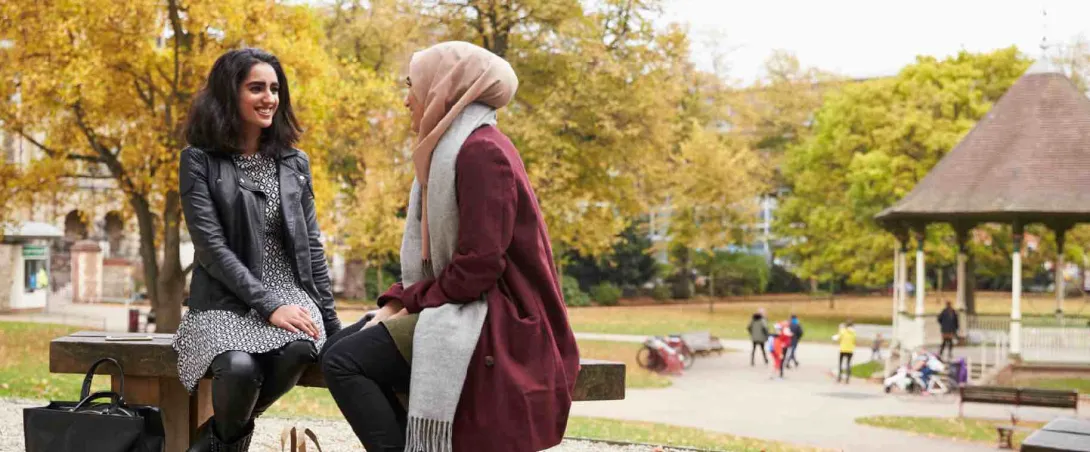Reciprocal care for nature and wellbeing
Project Lead

Challenges
Increasing use of outdoor spaces is one way the Scottish Government measures the prosperity and well-being of its citizens. Encouraging, managing, and investing in outdoor recreation has cross-sectoral policy significance relating to health, planning, environment, education, and tourism. There are the ‘Our Natural Health Service’ programme and ‘green and nature prescription’ initiatives which aim to integrate the outdoors as a nature-based solution for public health challenges. Policymakers, practitioners, and scholars are increasingly recognising the need to cultivate conditions for a reciprocal relationship between people and the environment, one that nurtures the human community and integrates care for, and responsible access to, nature by people. Greenspace quality can also perform a civic role by encouraging people outdoors which can bring financial benefits through contributions to business.
Childhood experiences shape participation in outdoor recreation and environmental stewardship behaviour. Nature engagement is a learned behaviour which highlights the influence of role models and a need to understand early life-course (dis)engagement moments and the development of associated capabilities. Our previous work has identified key transition points where nature engagement changes, with place and gender as contributing factors. There is a ‘gender gap’ in the use of the outdoors; parks and recreational areas are used differently (and frequently less often) by girls than boys, and emerging demand among policy and practice is to understand the behaviour toward, and experience of, nature by teenagers.
Research on the benefits of greenspace has identified quality as of more importance than quantity. This identifies a key gap in the robust analysis of the costs and benefits of greenspace investment. Despite ongoing interest in the characterisation of spatial qualities of greenspaces, definitions and indicators of environmental quality are seldom uniform. With increasing emphasis on the multi-functionality of these spaces, there is also a need to further investigate user functionality, contribution to biodiversity conservation, public health, and mitigation of climate change effects. It is also important to bring together different knowledge from across sectors for novel and transformative gain.
Questions
Solutions
The purpose of this project is to gain a comprehensive understanding of the mechanisms through which both diverse and responsible engagement with, and investment in, quality outdoor nature places can be promoted.
Investing in quality greenspace
To support investment in quality greenspace, we are synthesising definitions of quality characteristics and metrics and are developing and demonstrating the applicability of a ‘toolkit framework’ for measuring the costs and benefits.
Childhood/young adult nature-engagement
This project is exploring the association between childhood nature engagement and well-being through a life course lens, generating user-led perspectives on greenspace quality, a particular population’s (dis)engagement with and behaviours toward the outdoors. This field investigation pays particular attention to the personal experience of greenspace and the temporal relationship with and derived benefits from nature. This provides a voice for a group who are seldom the protagonist of nature-engagement research. The project is producing new knowledge on the use of, behaviours in and relationship with greenspaces for a particular group of young people to inform education-related policy, planning and interventions to promote health, well-being, and responsible outdoor use.
Nature engagement capabilities
Barriers to using the outdoors suggest they are multiple, co-occurring and reinforcing, and that the many identities that any one person inhabits could shape differences in outdoor use patterns between population subgroups. Our blending of an integrative public health behaviour change model with research on ‘cognitive maps’ about the environment is developing the idea of ‘capabilities’ for nature engagement and how interventions to increase the use of the outdoors can help enable and empower people to engage with the outdoors more fully. A new biodiversity-health framework and our current empirical work investigating transcendent experiences associated with Scottish landscapes identify a potential pathway for biodiversity’s contribution to wellbeing. Our research into irresponsible access suggests that many of those acting irresponsibly know better but are unable to act better in the moment. A desk-based synthesis brings these together. The field-based research will utilise a unique combination of methods to unpack these complex issues.
Given the multiple drivers of this project, we are working with stakeholders from across sectors to generate timely, consequential, and solutions-oriented syntheses and new evidence to support strategic decision-making.
Project Partners
Progress
2023 / 2024
Year 2 highlights:
Investing in quality greenspace (WP1): Eighteen key indicators of high-quality green and blue spaces were identified through surveys and workshops with land managers, policymakers, programme leaders, and businesses. These indicators – and the barriers to achieving them – will form the basis of a new toolkit for measuring and improving greenspace quality across Scotland.
Engaging children and young people (WP2): A report on outdoor learning in early years and schools has been finalised and published. A new long-term study on girls’ engagement with nature has also begun, with the first round of participants showing strong enthusiasm for continuing involvement.
Virtual nature tours (WP3): A digital “walk-through” of a forest path in Loch Lomond and the Trossachs National Park has been created to test whether virtual tours help people connect with nature before visiting. Surveys and focus groups show who benefits most from this approach and what features are most useful. Explore it here: Virtual Forest Path Tour.
Stakeholder engagement (WP4): A broad stakeholder network continues to shape the research and its impact, including input on using outdoor spaces to support public health priorities.
Challenges: Adjustments were made to better reflect real-world conditions, such as shifting the youth study focus to urban areas and revising recruitment strategies.
Overall: All Year 2 objectives were achieved, with findings already informing the next stage of work.
2022 / 2023
Investing in quality greenspace (Work Package 1/WP1)
We conducted a scoping review to identify how greenspace quality is currently measured, and how multifunctionality is incorporated. We identified 68 greenspace quality indicators, across the Scottish Government's (SG's) four capitals approach: environment, people, community and business. An interim report has been submitted, a literature database compiled, and a draft greenspace quality indicator online tool has been developed. These indicators will form the basis of Year 2's research, which involves working with stakeholders to validate indicators.
Childhood/young adult nature-engagement (WP2)
We undertook a narrative literature review to examine whether nature engagement during Early Learning and Childcare and Primary School, through outdoor learning/education programmes encourages subsequent recreational visits to the outdoors for secondary school age/young adults. A shift in focus of the literature synthesis from linkages between childhood nature engagement in general and wellbeing to outdoor education/learning and subsequent recreational visits to the outdoors, was informed by policy preferences. Findings were organised by barriers, opportunities and capabilities. Gender and age were also considered. We identified insights of how different types of programmes might factor into the impact on a pupil's life course and future recreational visits. We emphasise the potential that outdoor learning/education have as a mechanism to facilitate equitable engagement with nature. We highlight potential ways to overcome barriers to implementing outdoor learning/education. A draft report has been submitted to stakeholders for feedback.
We developed a research design protocol for our longitudinal lived experience research with pre-teen to teenage females that will explore (non)engagement with green/blue species. The protocol considered scope, sampling criteria and recruitment process. Study ethics has been submitted an approved.
Nature-engagement capabilities (WP3)
We have examined the Scottish Outdoor Access Code as a source of data for insight into reciprocal care. We identified data from previous Strategic Research Programmes to provide additional insight. We developed a research plan for our 'virtual nature' case study, refining the case study location and our method for constructing virtual tours. Ethics approval has been confirmed.
We have built an extensive stakeholder network, including SG policy teams and external stakeholders, consisting of three tiers, each playing a different role. In consultation with stakeholders we obtained input to WP1 protocol, and honed research focus and scope to fit policy for WP2 and WP3. We have also developed an impact plan template. We have followed a modified format for 'mini-monologues with stakeholders about impact' allowing stakeholder preferences to broaden reach to wider stakeholder network.
Previous Projects
Related Projects
Rural Landscapes and Community Wellbeing
The aim of the research within this RD is to improve understanding of issues around (re-) engagement of people with Scotland’s landscapes and natural environment. There are three key objectives set out for the research:
- Developing and applying a framework for understanding access to and engagement with natural landscapes
- Understanding opportunities to facilitate (re-)engagement with the land
- Examining linkages between environmental qualities and wellbeing
Natural Asset Inventory and Natural Capital Accounts
Natural Asset Inventory and Natural Capital Accounts: the aim is to develop a spatially-referenced register of Scotland’s natural assets and contribute to a set of natural capital accounts for Scotland that can over time track the progress of Scotland's green growth aspirations.
